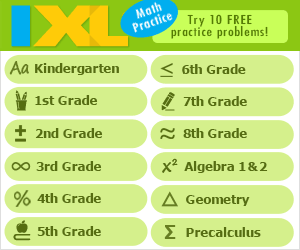8th Grade English Language Arts - Literature Standards
To work on eighth grade literature standards, click on the numbers below to visit pages of internet resources for each of the learning standards.
Checks for Understanding are at the top of this page. Scroll down to find internet resources related to the State Performance Indicators (SPIs).
Checks for Understanding (Formative/Summative Assessment)
0801.8.1 Reading Comprehension - Use previously learned strategies to comprehend informational texts (e.g., formulating questions before, during, and after reading; visualize, predict, identify the writer's purpose). 0801.8.2 Sequence - Sequence and identify the plot's events, their causes, and the influence of each event on future actions. 0801.8.3 Plot Development - Identify plot development techniques (e.g., foreshadowing, flashbacks) and explain their function in the text. 0801.8.4 Describe Characters - Identify and describe characters' (major/minor, antagonists and protagonists) features and relationships in literary texts. 0801.8.5 Moral Dilemmas - Identify and analyze moral dilemmas in works of literature, as revealed by characters' motivation and behavior. 0801.8.6 Conflict - Differentiate between internal and external conflict. 0801.8.7 Kind of Conflict - Identify the kind(s) of conflict (e.g., person vs. person, person vs. self, person vs. environment, person vs. technology) present in literary plots. 0801.8.8 Basic Plot Elements - Identify the basic elements of plot (i.e., exposition, rising action, climax, falling action, resolution/denouement). 0801.8.9 Setting - Identify and analyze the setting (location and time) and its impact on plot, character, and theme in literary texts. 0801.8.10 Character Development - Identify how the author reveals character (e.g., what the author tells us, what the characters say about him or her, what the character does, what the character says, what the character thinks). 0801.8.11 Point of View - Analyze the narration and point of view (e.g., first person, third person, third-person limited, third-person omniscient) in literary texts. 0801.8.12 Genres - Consider how forms and conventions within genres (e.g., poetry, drama, essays, short stories) affect meaning. 0801.8.13 Figurative Language - Comprehend and use figurative language (e.g., idioms, metaphors, similes, personification, hyperbole, pun). 0801.8.14 Sound Patterns - Identify sound patterns (e.g., alliteration, onomatopoeia, rhyme scheme, assonance, internal rhyme, slant rhyme, repetition) and figurative language (e.g., metaphor, simile), and other conventions of verse (e.g., limerick, lyric, narrative, haiku) in poetry and explain how these contribute to the poem's meaning and to the poem's effect. 0801.8.15 Structural Elements - Explain the purpose and use of structural elements particular to dramatic literature (e.g., scenes, acts, cast of characters, stage directions) in plays that are read or viewed. 0801.8.16 Theme - Identify and explain the theme of a literary text, distinguishing theme from topic. 0801.8.17 Stated or Implied Theme - Identify and explain the development of stated or implied similar themes across two or more literary texts. 0801.8.18 Plot Conflict - Distinguish among the types of literary plot conflicts (e.g., person vs. person, person vs. self, person vs. environment, person vs. technology, person vs. society). 0801.8.19 Historical Period - Identify the historical period in which a literary text was written and explain the text in light of this understanding. 0801.8.20 Viewpoint - Recognize that the author's viewpoint may or may not reflect the culture or mores of the time in which the author lives. 0801.8.21 Allusions - Recognize and analyze biblical, classical, cultural, historical, and literary allusions. 0801.8.22 Allegory - Explore the concept of allegory. State Performance Indicators
SPI 0801.8.1 Plot Elements - Demonstrate an understanding of the basic elements of plot: exposition, rising action, climax, falling action, resolution/denouncement. SPI 0801.8.2 Identify Point of View - Identify and analyze the author's point of view (i.e., first person, third person, third-person limited, third-person omniscient). SPI 0801.8.3 Change in View - Determine how a story changes if the point of view is changed. SPI 0801.8.4 Different Genres - Distinguish among different genres (e.g., poetry, drama, biography, novel) using their distinguishing characteristics. SPI 0801.8.5 Similar Themes - Analyze the development of similar themes across two or more literary texts. SPI 0801.8.6 Reveal Character - Identify and analyze how the author reveals character (i.e., what the author tells us, what the other characters say about him or her, what the character does, what the character says, what the character thinks). SPI 0801.8.7 Literary Elements - Identify and analyze examples of literary elements that shape meaning within context (i.e., flashback, foreshadowing, irony, mood, symbolism, tone). SPI 0801.8.8 Analyze Figurative Language - Analyze figurative language (i.e., idiom, metaphor, simile, personification, hyperbole, pun) within context. SPI 0801.8.9 Sound Devices - Analyze examples of sound devices within context (i.e., rhyme scheme, alliteration, free verse, repetition, internal rhyme, slant rhyme). SPI 0801.8.10 Kind(s) of Conflict - Identify the kind(s) of conflict present in a literary plot (i.e., person vs. person, person vs. self, person vs. environment, person vs. technology). SPI 0801.8.11 Moral Dilemma - Identify and analyze a literary character's moral dilemma. SPI 0801.8.12 Time Periods - Recognize and identify words within context that reveal particular time periods and cultures. SPI 0801.8.13 Culture - Determine the influence of culture and ethnicity on the themes and issues of literary texts. SPI 0801.8.14 Author's Purpose - Identify the author's purpose for writing. Review Help Resources to help review Eighth Grade English Language Arts standards
Search Internet4Classrooms

Custom Search






